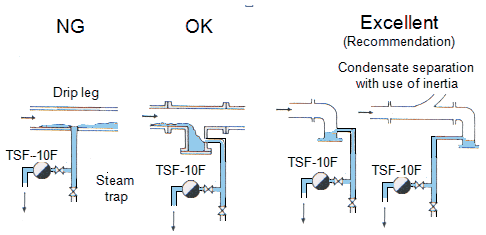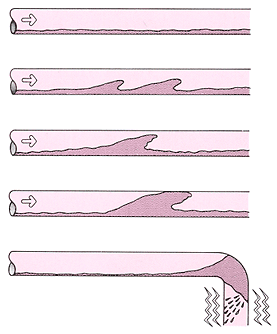Steam Transportation : Necessity of Steam Condensate Removal
Necessity of Steam Condensate Removal and Its Procedure
Condensate generates in steam transport pipe by heat release. If there is no warmer in the boiler, steam left from the boiler usually has 2% of moisture.
Moreover, carry-over from the boiler also occurs.
Therefore, while removing condensate enough by a steam header immediately after coming out of a boiler, by the time it arrives at purpose-of-use place, it is necessary to remove this as promptly as possible.
Condensate in the transport piping accumulates on the bottom of piping, and then pushed in the flow direction of steam by the steam which flows at high-speed.
If condensate removal is insufficient, the wave of condensate in the bottom becomes higher and higher, and then arrive at the peak of piping finally, and condensate which become piston-like is pushed by steam, and advances at high speed.
When this collides with a valve or a pipe bend part, big sound and vibration are produced.
This phenomenon is called as water hammer. This may produce not only noise but joint loose to cause leak or may destroy a valve.
To prevent such water hammer, sufficient condensate removal is required.
Condensate removal in transport piping is different from that in ordinary steam use equipment since steam flows at high speed.
Only by attaching a drip pipe to the bottom of steam main, condensate of high-speed steam just bypasses the inlet of the drip pipe, and does not flow into the drip pipe.
It is necessary to prepare drip leg and to catch condensate.
If there are valves such as pressure reducing valve, or pipe bend parts, condensate accumulated on the bottom disperse at them, and removal becomes difficult.
Condensate removal is required in front of these products.
Condensate tends to be dragged by steam flow. However, since specific gravity of condensate is larger than that of steam, even when steam changes its direction, condensate continues going straight without changing the direction.
In a pipe bend part, it is especially important to collect condensate using this inertia.
Even in a straight pipeline without an obstacle, it is necessary to remove condensate, namely, discharge water every about 50 m.
In an overheated steam transport pipe, since temperature of a pipe wall does not become below a saturation temperature, condensate does not generate during operation.
However, since condensate certainly generates at the time of starting, steam trap is required.
Condensate Removal in Transport Piping

Generation of Water Hammer

Movie
You need Windows Media Player to watch the movie. To download Windows Media Player, click the below link.